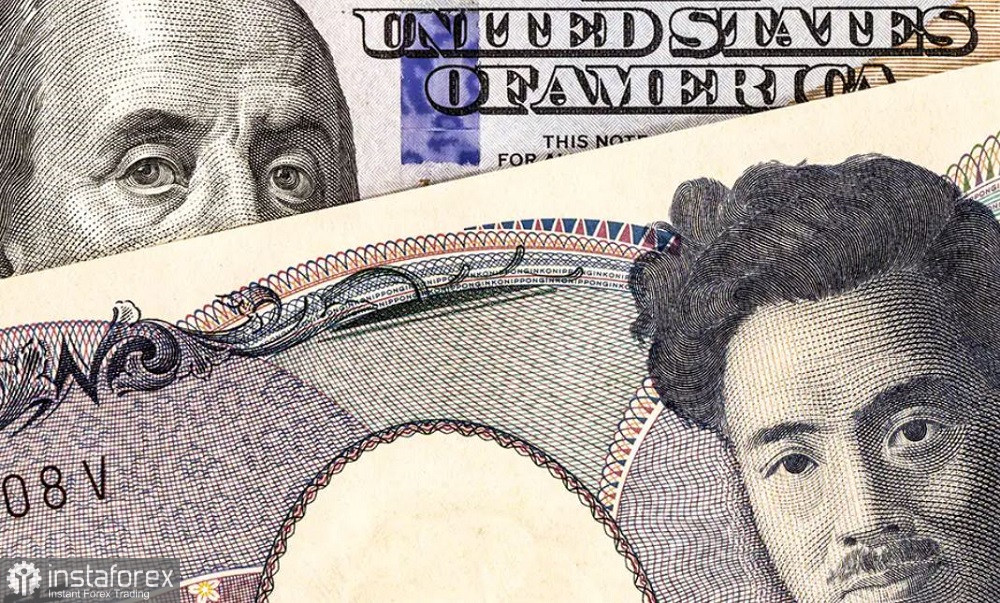The USD/JPY pair continues to demonstrate a bullish impulse. The yen has solidified around the 149 level and is approaching the psychologically significant target of 150.00. Judging by the strength of the upward movement, overcoming this level is only a matter of time. History is repeating itself for the third time, counting from 2022.
Drawing such parallels allows us to speculate on how this entire story will end. In brief, buyers of USD/JPY have approximately 250 points of profit left in reserve. Beyond that lies uncharted territory untouched by traders in "modern history." In this price range, risks increase significantly—either due to actions by Japanese authorities or through self-regulation. In the former case, it involves currency interventions, while in the latter, it relates to traders independently deciding to close long positions (again, due to fears of interventions).

Last year, the pair reached a yearly high (151.92) and reversed direction by 180 degrees, presumably remembering that at the level of 151.96, the patience of Japanese authorities in 2022 finally wore thin. A massive currency intervention was conducted then, strengthening the yen by several thousand points. However, in 2023, other fundamental factors, such as the weakening of the greenback amid slowing inflation in the U.S. and hawkish hints from the head of the Bank of Japan, played a role. Due to a combination of these factors, the USD/JPY pair plummeted over a thousand points in just two months, reaching 140.27 in December.
Yet, within a few weeks in January, the pair recovered almost all the lost positions. If U.S. inflation does not disappoint the American currency next week, buyers of USD/JPY will not only consolidate around the 150 level but may also aim for higher price levels, up to the 152 level, which serves as a conditional "red line" for Japanese authorities.
The point is that we can now speak of systemic reasons for the rise of USD/JPY, which a priori cannot disappear or be neutralized in a short period. Hence, the prolonged nature of the bullish trend. The foundation for this was evidently laid by the U.S. regulator, which tightened its rhetoric this year. The Bank of Japan, on the contrary, debunked rumors of normalization of monetary policy in the foreseeable future.
In other words, the Federal Reserve and the Japanese regulator have switched places in the context of the messages they convey, and the macroeconomic reports published in January only fueled interest in buying USD/JPY. The rise in overall inflation in the U.S., strong Nonfarm Payrolls, and robust growth in the American economy in the fourth quarter – all these releases strengthened the greenback. Additionally, hawkish comments from Federal Reserve representatives, indicating that the central bank will not rush with monetary policy easing, further contributed to the bullish sentiment.
In late December, the probability of a rate cut in March was nearly 80%. After the publication of the aforementioned macroeconomic reports, this probability decreased to the current 17%. However, the market is 50% confident that the Federal Reserve will take this step following the May meeting. Given the relatively high degree of confidence (50/50), any doubts about the realization of this scenario will be interpreted in favor of the greenback. Therefore, if the Consumer Price Index in January (to be released Tuesday, February 13) shows acceleration, the chances of a May easing of monetary policy will decrease, and the dollar bulls will organize another rally. In this case, the market will shift its expectations to June, assuming a sustained decline in U.S. inflation and labor market cooling.
The yen is forced to follow the greenback since it has no arguments in its favor for a turnaround. Bank of Japan Governor Kazuo Ueda said on Friday that the chances of maintaining accommodative conditions are very high, "even in the case of abandoning negative rates." On Thursday, his deputy, Shinichi Uchida, voiced a similar position. According to him, the regulator plans to maintain a "stable and accommodative monetary environment."
It is also worth noting that the Bank of Japan will decide on adjusting monetary policy no earlier than April–May, based on negotiations between union representatives and businesses regarding wage increases. Many experts doubt these negotiations will end successfully (i.e., successfully enough for the central bank to start normalization of policy).
Thus, the established fundamental background contributes to further development of the bullish trend in USD/JPY, especially if January inflation in the U.S. favors the dollar bulls. In this case, in the medium-term perspective, the pair will return to the "abyss boundaries," i.e., the range of 151.50–152.00.
The technical analysis also indicates the priority of long positions. On all "higher" timeframes (from H4 and above), the pair is between the middle and upper lines of the Bollinger Bands indicator. In addition, on the four-hour and weekly charts, the Ichimoku indicator has formed one of its strongest bullish signals, the "Parade of Lines." It is advisable to use corrective pullbacks for opening long positions with the initial target at 149.60 (upper line of the Bollinger Bands indicator on D1). The subsequent targets are the well-known levels of 150.50 and 151.00, around which it is advisable to take profits due to the likely reaction from Japanese authorities (at least in terms of verbal interventions).





















